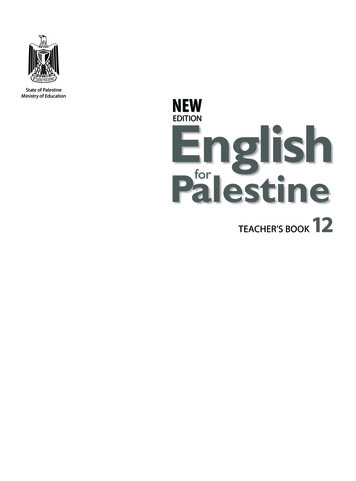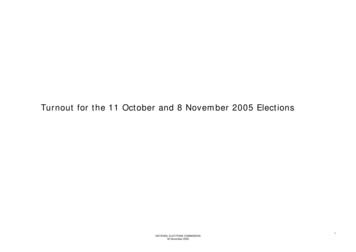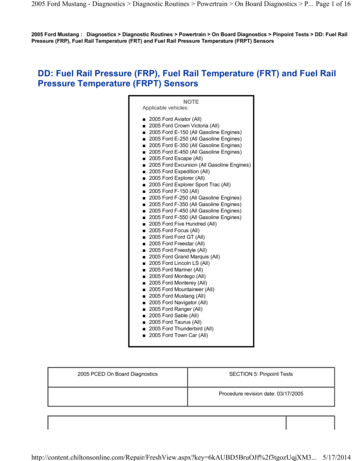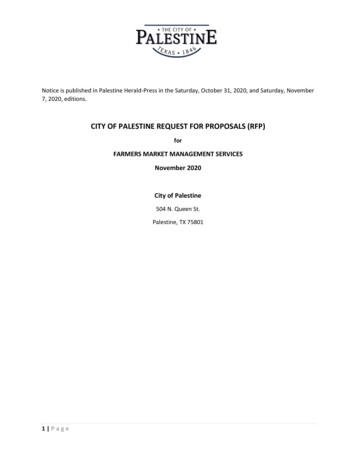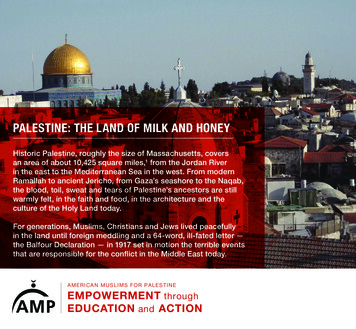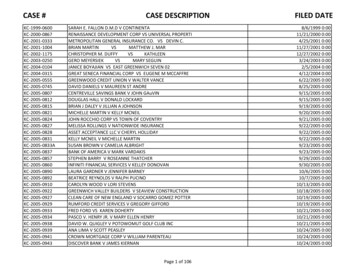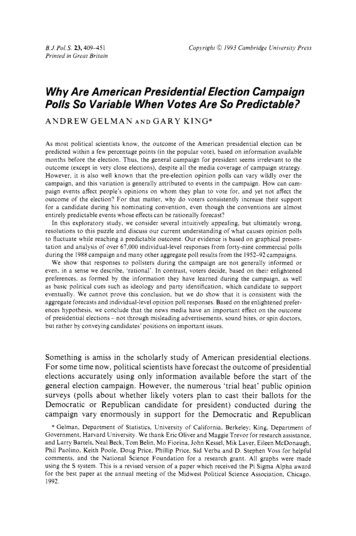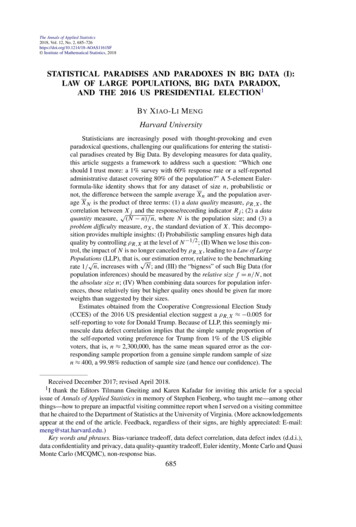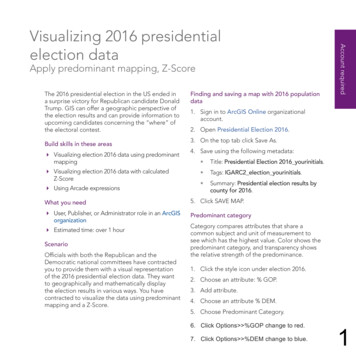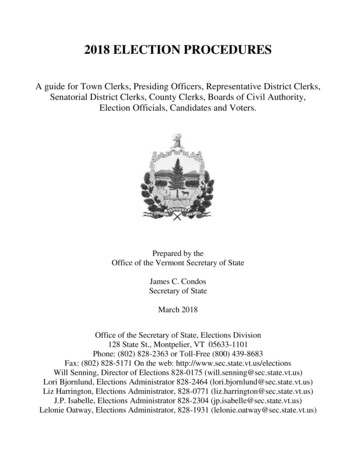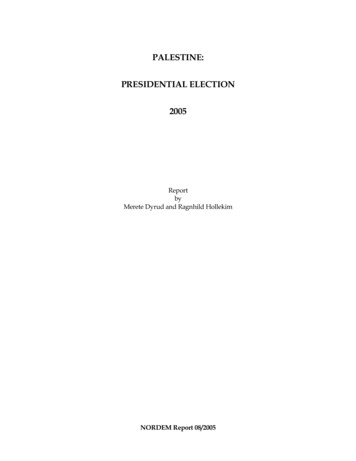
Transcription
PALESTINE:PRESIDENTIAL ELECTION2005ReportbyMerete Dyrud and Ragnhild HollekimNORDEM Report 08/2005
Copyright: the Norwegian Centre for Human Rights/NORDEM and Merete Dyrud andRagnhild Hollekim.NORDEM, the Norwegian Resource Bank for Democracy and Human Rights, is aprogramme of the Norwegian Centre for Human Rights (NCHR), and has as its mainobjective to actively promote international human rights. NORDEM is jointlyadministered by NCHR and the Norwegian Refugee Council. NORDEM works mainlyin relation to multilateral institutions. The operative mandate of the programme isrealised primarily through the recruitment and deployment of qualified Norwegianpersonnel to international assignments which promote democratisation and respect forhuman rights. The programme is responsible for the training of personnel beforedeployment, reporting on completed assignments, and plays a role in research related toareas of active involvement. The vast majority of assignments are channelled through theNorwegian Ministry of Foreign Affairs.NORDEM Report is a series of reports documenting NORDEM activities and ispublished jointly by NORDEM and the Norwegian Centre for Human Rights.Series editor: Siri SkåreSeries consultants: Hege Mørk, Gry Kval, Christian Boe AstrupThe opinions expressed in this report are those of the author(s) and do not necessarilyreflect those of the publisher.ISSN: 1503–1330ISBN-13: 978-82-8158-001-5ISBN-10: 82–8158–001 –1NORDEM Report is available online blikasjonsliste.html
PrefaceIn connection with the Presidential Elections 9th of January 2005 in Palestine, theEuropean Union Election Observation Mission (EUEOM) was established. EUEOM wasformally invited by the Palestine Authorities (PA) to observe the elections on the WestBank, Gaza Strip and East Jerusalem.EU has developed a long term methodology for the conduct of its EOMs, in accordancewith international practice. The key objectives of the mission were to1:Conduct a comprehensive and national analysis of the electoral process.To be able to offer an impartial, balanced and informed assessment of the election, witha series of recommendations for the further consolidation and development of thedemocratic process in the country.By the presence of observers, to seek to reduce tension, minimise instances of fraud,intimidation and violence and hopefully give confidence to contestants and voters toparticipate freely.The mission was established on 8 December 2004 and ended the 21st of January 2005and was one of the largest EUEOMs The European Union has deployed so far.The mission’s Chief Observer was Mr Michel Rocard, former prime minister of France.The Core Team consisted of 12 persons and was deployed 8 December. On 15December 42 Long Term Observers (LTOs) were deployed and before Election Day, onthe 4 of January, Short Term Observers (STOs) from 26 countries were deployed. Inaddition 28 Members of the European Parliament participated as observers on ElectionDay.NORDEM seconded 2 LTOs who were deployed in Ramallah and Hebron/Jenin. Inaddition 13 STOs from Norway were seconded for the Election Day and were deployedin different districts on the West Bank and East Jerusalem.All opinions expressed in this report are the authors’ responsibility and do notnecessarily reflect the views of the Norwegian Centre for Human Rights.The Norwegian Centre for Human Rights / NORDEMUniversity of OsloJanuary, 20051EUEOM Long Term Observers Referance Manual, West Bank&Gaza 2005
ContentsPrefaceContentsMap of CountryIntroduction1Political background2Historical background2Refugees and the establishment of PLO3The Israel – Palestinian conflict4Political parties and movements4Prisoners in Israel detention7Gender8The Legislative Framework9East Jerusalem10The Election Appeals Court10The Electoral Administration11Voter and Civic Education13Voter Registration13Candidate registration14The Election campaign16Palestine-Israel conflict and the problem of movement17Gender – a “no-issue” in the presidential election campaign17Abuse of administrative resources18Intimidation and violence between groups/movements18The period of silence 24 hours before Election Day19The Media19Observation on the Polling Day20Long Term Observer: Merete Dyrud20Observation of the opening21Observation of the polling21Observation of the closing, counting and tabulation22Long Term Observer: Ragnhild Hollekim22Observation of the opening23Observation of the polling23Observation of the closing, counting and tabulation24
Observation on the Polling Day: STOs25West Bank25Observation of the opening27Observation of the polling27Observation of the closing, counting and tabulation29East Jerusalem29Voting results34The review of Complaints Process35Conclusions and recommendations36Comments on the election observation mission38Appendices39Observing organisation’s statement/preliminary report39Copy of observers’ reporting form39
Map of Country
Palestine: Presidential Elections - 20051IntroductionThe observation of elections is an important component in promoting human rights anddemocratisation. The mission’s Chief Observer, Mr Michel Rocard, said holding ademocratic election under occupation is fraught with difficulties and is therefore a rareevent.“In this case it has happened because it is essential. Following the death of PresidentYasser Arafat, the Palestinian people and national institutions chose to respect theprovisions in the Basic Law and embark on an electoral process to identify their newleader. This decision was a courageous one and shows a demand for democracy”2.The 9 January election for the president of the Palestinian Authority represented agenuine effort to conduct a regular electoral process.3 Despite the difficult and tenseconditions due to occupation and continuing violence, the electoral authorities madeadequate and sufficient arrangements for voters. However the findings from the EUEOMobservers express several concerns, but also suggestions for improvements.In making an assessment of the entire electoral process the EUEOM considered4:The impartiality of the electoral administrationThe campaign freedoms afforded to political contestants, including the fair use of stateresourcesThe fair access for all contestants to the media, and in particular the state mediaThe universal franchise afforded to votersThe conduct of the polling and counting of votersAny other issues that concern the democratic nature of the electionThis report is based on the reported findings of the two Norwegian LTOs from the preelection, Election Day and post-election phase, and the 13 STOs on Election Day.Findings from other election districts not covered by Norwegian observers, and alsomore in-depth analysis of some of the above mentioned issues, will be given in theEUEOM report on the following web-side:http://europa.eu.int/comm/external realtions/human rights/eu elections ass observ/index.htm2EU Preliminary Statement 10.01.053EU Preliminary Statement 10.01.054EUEOM Long Term Observers Referance Manual, West Bank&Gaza 2005
Palestine: Presidential Elections - 20052Political background5Explaining the political background of Palestine is a challenge. It is closely linked to thehistory of the Israeli-Palestinian and general Arab-Israeli conflicts, many of which goesseveral thousands years back in time. A short historical background will be given,however the main presentation has to be limited to present time and with the main focuson the political situation during the pre election phase.Historical backgroundIn 1917 the British Foreign Minister, Lord Arthur Balfour issued a declarationannouncing his Government support for the establishment of the “Jewish NationalHome” in Palestine. In 1921 the British divided the region in two: east of Jordan becamethe Emirate of Transjordan, the west bank of Jordan became the Palestine Mandate.During the persecution of Jews in Europe (1935-1945) an immigration of Jews toPalestine increased. The United Nations resolution (UN GA Res 181) in 1947 partedPalestine in two states in such a way that each state would have a majority of its ownpopulation, although some Jewish settlements would fall within the proposed Palestinianstate and many Palestinians would live within the boundaries of the proposed Jewishstate.In May 1948 the British evacuated Palestine and the state of Israel was proclaimed. FirstArab-Israeli war involving Egypt, Syria, Jordan and Iraq took place. The state of Israelencompassed over 77% of the territory. Palestine was divided into three parts, eachunder separate political control. This created the first wave of Palestine refugees, withmore than 700 000 Palestinian refugees abroad.The UN GA Res. 194 (III) of 1949 which stated the right of the Palestinians to return totheir country or being compensated, did not bring any changes.In 1964 The Palestine Liberation Organisation (PLO) was established on the initiative ofEgypt’s president Abdel Gamal Nasser and the Arab League.In 1967, the Israeli military carried out a “pre-emptive” attack and defeated the Egyptian,Syrian and Jordanian armies in the area. The six day war established Israel as thedominant military power in the region. Israel occupied the West Bank and EastJerusalem from Jordan and the Gaza Strip and Sinai Peninsula from Egypt and the GolanHeights from Syria. This created the second wave of Palestinian refugees.November 1967 the UN Security Council Resolution 242 called for Israel to withdrawfrom “occupied territories” meaning the West Bank (including East Jerusalem) and theGaza Strip. The Israeli governments have not accepted this understanding of theterritories status as occupied.In 1973, the Egyptian and Syrian army stormed over the Sinai Peninsula and the GolanHeights, during Yom Kippur, claiming the “territories” still occupied by Israeli forces.The attack was eventually repelled.5The main source of this presentation is The Palestinian Academic Society of the Study of InternationalAffairs (PASSIA), Daily Press Summary provided by the core staff during the EUEOM pre electionobservation phase and LTOs interviews of presidential candidates or their campaigners.
Palestine: Presidential Elections - 200531979 brought the Camp David I accords. The first agreement led to the Egyptian-IsraeliPeace treaty and the second agreement proposed to grant autonomy to the Palestinians inWest Bank and Gaza Strip.In 1987, the first Palestinian Intifada started as a massive uprising against the Israelioccupation in West Bank and Gaza Strip.The Islamic Resistance Movement (HAMAS) and the Islamic Jihad increased theirsupport in occupied territories. This led to a confrontation with Israeli forces and thebeginning of secret negotiations between PLO and the Rabin Government.In 1993 the Israel-PLO Declaration of Principles (DOP) was signed in Washington,based on a mutual recognition of Israel and PLO and Israeli withdrawing from the GazaStrip and Jericho with further withdrawals in areas of the West Bank within five years.In addition DOP specified the provisions for holding elections in an Interim Agreementfor the transfer of authority from the Israeli military government to the Palestinian(Interim Self-Government) Authority (PA).In 1995 the Oslo II Agreement was signed, foreseeing 7% of territory going to fullPalestinian control and 21% to joint Palestinian-Israeli control. The same year YitzhakRabin was assassinated and Netanyahu (Likud) was elected prime minister of Israel.This resulted in Israeli policy moving away from Oslo Accords. The Oslo II Agreementfollowed “Oslo I”, the Declaration of Principles (DOP), signed in Washington in 1993.In 1996 was the first ever Palestine election for president (Ra’is) of PA (the executiveauthority) and the election of the Palestinian Legislative Council (PLC). Yasser Arafatwon the presidential election and 88 members were elected to the PLC. The voter turnout was 75% and observers characterised the election as generally credible, with somereservations.In 2000 the Camp David II summit ended in failure of the Palestinian-Israeli talks overEast Jerusalem leading to the second Intifada. In 2002, Al-Aqsa Martyrs started suicideattacks inside Israel whom responded with re-invasion of most of the West Bank. TheRoad Map was launched by international community as framework for addressingproblems of peace and reform, while the suicide bombings and Israeli “targeted killings”continued.Nov 11 2004 Yasser Arafat dies at the age of 75.Refugees and the establishment of PLO6An important issue in understanding the political framework of the election is the issuesof the refugees and stronghold of PLO.After the establishment of an Israeli state there were violent confrontations with theescalation of a regional war in May 1948. By the first half of 1949 some 700 – 740 000Palestinians - about half the population - had fled or been expelled form the country. Thenext wave of refugees came as a result of the Six Day War in June 1967 where Israelreplaced Jordan and Egypt as occupying powers in the West Bank and Gaza Strip.6The main source of this presentation is Human Rights Report no 7 May 1996, Report on the PalestinianElections January 1996, Nils Butenchøn, Kåre Vollan (eds) and PASSIA (see also enclosed maps andfigures from PASSIA/UNRWA on the refugee situation)
Palestine: Presidential Elections - 20054The Palestinian main problem was a lack of effective organisation and representation.The Palestinian National Movement (PLO) was established in 1964 under stronginfluence of the Arab states. In 1969 PLO was taken over by more independent Palestinegroups with Yasser Arafat’s Fateh as the leading force. Arafat led PLO from refugeecamps in excile (Jordan, Libanon and Tunis) and finally in Palestine.In refugee camps the Palestinians organised activities in several committees. PLObecame the umbrella organisation for different committees and different politicalbranches – Arabic, Christians, Leftist, Fateh, more militant groups etc. In 1974 thePalestine National Council (PNC) was established as the highest authority of the PLOand the Palestinian National Assembly in exile. In 1996 before the first election for thePLC, the PNC consisted of 560 members residing in many different countries.The first Intifada starting in December 1987 shifted the gravity of Palestinian politicalinitiative from the PLO leadership in Tunis (in exile) to the occupied territories. In 1988the PNC adopted the two state solutions and also declared the establishment of the Stateof Palestine in what was known as the occupied territories and condemning all forms ofterrorism.The centrality of the Palestine question made it a top priority in American diplomacyfollowing the Gulf War. Even though PLO was not officially represented in thenegotiation in Madrid and Washington, the Palestine delegation clearly stated that theyreceived their instruction from PLO and Arafat. When the Israel-PLO Declaration ofPrinciples was signed in Washington in 1993, “Oslo I”, the PLO formed the “PalestinianAuthorities” (PA) with “self-governing” powers.The stronghold of PLO and especially the party Fateh among refugees is visible whenvisiting the refugee camps in the West Banks7.The Israel – Palestinian conflictThe Palestine territories are under Israeli occupation. The EUEOM stated clearly that theongoing conflict due to the Israeli occupation was not within the mandate of thisobservation, unless it was incidents which directly influenced on the election. The reportwill only focus on incidents that clearly influenced the election.One important issue was expected to be the lack of freedom of movement for candidates,voters, electoral bodies and journalists. Another could be political motivated arrests.Political parties and movementsPalestine has a wide variety of political parties and movements. In the presidentialelection four of the candidates were registered as independent candidates and threecandidates represented political parties. The presentations of the candidates are givenunder the headline “Candidate registration”.However to understand the political landscape in the presidential election an introductionof the main political parties are necessary. In this presentation the parties/movements aredivided in three main categories: Fateh, the Leftist parties and the Islamic parties.7There were no presence of Norwegian LTO or STOs in Gaza Stripe and the refugee camps there.
Palestine: Presidential Elections - 20055Palestinian National Liberation Movement (FATEH)FATEH is the acronym for Harakat At-Tahriri Al-Filistiniya. Founded in Kuwait in1959 by Yasser Arafat and associates, and advocated armed struggle to liberatePalestinian lands. Headed by Arafat until his death and is the largest and strongest PLOfaction. Initially Fateh was a network of underground cells but in 1963 it was recognisedby a central committee, which took control of the PLO at the 5th Palestinian NationalCouncil (PNC) in Cairo in 1969. Fateh adopted the principle of political pluralism withinthe PLO. Until the 1970s, it followed a guerrilla strategy, with its military wing AlAssifa and squads – known as Fateh Hawks and Black Panthers, operation in theOccupied Palestinian Territories. They played a central role in the Intifada and were amember of the United National Leadership of the Uprising (UNLU). Fateh is representedin the PLO Executive Committee by three members.Fateh advocates a democratic, secular, multi religious state.Prior to the election one of the last candidates to withdraw was Marwan Barghouti, theprominent West Bank leader of Fatah’s Al Aqsa Brigades, currently serving five lifesentences in an Israeli jail. Barghouti enjoys widespread support on the basis of hisleadership of the armed movement during the recent Intifada. His candidacy was one ofthe main obstacles to Mahmoud Abbas’ unassailable position in the polls and alsothreatened to split the Fateh vote.Mahmoud Abbas was the official presidential candidate of FatehThe official website: http://www.fateh.netThe Leftist partiesThere are several parties politically left of center in Palestine. Two of them wererepresented by presidential candidates.Palestinian People’s Party (PPP)PPP is an abbreviation of Hizb Ash-Sha’ab. PPP is the leftist PLO faction, founded inFebruary 1982 in the Occupied Palestinian Territories as the Palestinian CommunistParty. It broke with its Leninist past in 1991 and re-launched itself as a democratic,pragmatic and popular party. It was a member of the UNLU during the Intifada. PPP wasled by Bashir Barghouthi from 1982-98. In October 1998 the party held its thirdconvention and elected a three-member committee as General Secretariat – Han Amira,Abdel Majid Hamdan and Mustafa Barghouthi, who left the party in 2002. In 2003Bassam Salhi was elected as the PPP’s Secretary-General. PPP plays a more importantrole locally than in the PLO, where it is represented in the PLO Executive Committee bySulieman Najjab.Bassam Salhi was the official presidential candidate of PPPThe official website: http://www.palpeople.orgDemocratic Front for the Liberation of Palestine (DFLP)DFLP started as an extreme left Marxist-Maoist group led by Nayef Hawatmeh (AbuNouf). It was formed from a split in 1969 from the Popular Front for the Liberation of
Palestine: Presidential Elections - 20056Palestine (PFLP)8. Most supporters were from the intelligentsia, mainly Palestinianstudents abroad. The official headquarter is in Damascus. The party was a member of theUNLU during the Intifada. UNLU opposed to the Oslo process, but the role becamemarginalised after the signing of the Declaration of Principals (DOP). A DFLP-Arafatreconciliation took place in Cairo in Aug 1999. DFLP is currently represented in thePLO Executive Committee by Taysir Khailid.DFLP advocates a two state solution, with a democratic Palestinian state with equalrights for Jews and Arabs.Taysir Khalid was the official presidential candidate of DFLP.The official website: http://www.fas.orgIslamic movementsThere are several Islamic movements. The main ones are also by The Council of theEuropean Union defined as “terrorist organisations”. Since the foremost Islamic partiesand movements boycotted the presidential elections they had no official presidentialcandidates running for the election.Islamic resistance Movement (Hamas)Hamas is an abbreviation of Harakat al-Mouqawama Al-Islamiyya. This is a Palestinianfundamentalist political movement grown out of religious associations and alleged linksto the Muslim Brotherhood. Hamas emerged shortly after the outbreak of the firstIntifada in January 1988. The spiritual leader and founding father is Sheikh AhmadYassin, who was freed from an Israeli jail after nine years on 1 Oct 1997. The HamasCovenant, issued in Aug 1988, proclaims jihad against Israel. Hamas advocates anIslamic state in all of historic Palestine and the application of Shar’ia Law. Themovement is not a PLO member and worked independently from the UNLU during theIntifada, however Hamas does not question the role of the PLO as the representative ofthe Palestinian people at an international level. Hamas strongly opposes the OsloAgreements and the peace process. Through charitable efforts and the provisions ofeducational and health services Hamas has gained increased popularity among thepopulation. Hamas has been responsible for many attacks on Israeli targets, mostlycarried out by its military wing – the Iss Eddine Al-Qassem Units. There were severalincidents, especially in Gaza Strip in the pre-election phase and after the Election Day.Hamas boycotted the Palestine elections in January 1996. This was also the case for thispresidential election. Now it was a “passive boycott” and there were several indicationsthat branches of Hamas supported the opposition candidates as an alternative to the Fatehstronghold.In the local election December 2004 there were several candidates from Hamas, which ingeneral had great success getting candidates elected in different local legal councils.This clearly indicates the stronghold Hamas is gaining and which will be very interestingto observe in the Parliamentary Election which is planned for the 17 July 2005.8PFLP was established in 1967 by the Arab National Movement and was known for hijacking actions ledby Wadi Haddad, but became more moderate after 1973. PFLP rejoined with PLO in 1981. They led ananti-Arafat coalition from 1981, with a reconciliation to Fateh/Arafat in 1999. PFLPs official website:www.pflp-pal.org
Palestine: Presidential Elections - 20057The official website: http://www.palestine-info.co.uk/hamasOther Islamic movementsEven if Hamas is the largest Islamic movement in the Palestine territories there areseveral others of importance. One is Islamic Jihad Movement which split from theMuslim Brotherhood in the mid-1980s and formed as a separate militant Islamicmovement by Fathi Shiqaqi (assassinated 26 Oct 1995) and Abdul Aziz Odeh, bothrefugees from Gaza Strip. Islamic Jihad advocates armed struggle for the liberation ofPalestine. It does not see itself as a rival to the mainstream PLO but strongly opposes theOslo Accords.Prisoners in Israel detention9There are several Palestinian political prisoners (or by Israeli government called securityprisoners) in Israeli detention. Figures state:Total number of prisoners/detainees are: 7918In which:3484 men are in central prisons104062 men are in military camps11122 women are in women prisonsThe others are in different forms of detention.The prisoners/detainees are well organised within the camps and prisons and there arealso a high level of political activity. Several committees are established, among themfrom different political fractions.The right of detainees/prisoners to vote for the presidential election was an importantissue for the Palestine Authorities, whom negotiated the issue with the IsraeliAuthorities. The Israeli authorities refused to accept this and the reason given was thatthey consider the agreement of the 1996 election still valid. This agreement stated thatprisoners had no right to vote.The Israeli statement was opposed by the Palestine Authorities, whom together withdifferent organisations dealing with the issue of political prisoners made a joint effort tochange the Israeli Authorities statement. Minister Hisham Abdul Razeg from thePalestine Ministry for Prisoners Affairs announced that he would appeal to the IsraeliSupreme Court for letting the detainees/prisoners in Israel prisons and camps vote in thePalestinian presidential election12. However the Supreme Court refused the appeal acouple of days before Election Day.9Figures from the LTOs interview with representatives from the Mandela Institute, and their latest updatedfigures from 01.12.04. The numbers differs from official Israel figures, they do not include Palestiniansinside the green line or from east-Jerusalem).10These are persons whom are sentenced for more then 5 years in prison.11These are “administrative detainees”, detainees awaiting of court hearing or prisoners sentenced for lessthan 5 years.12Newspaper Al-Ayyam 03.01.05
Palestine: Presidential Elections - 20058GenderPart of the EUEOM mandate is to deal with the gender issue in political elections. Forthe presidential election this was almost a non existing topic. There was no femalecandidate, Mrs. Majida Al-Batch who was supposed to run as a candidate withdrew.There were no visible gender issues in the political campaign.Women organisations are many and well organised in Palestine. Several started inrefugee camps abroad. PLO covers several women organisations, also on the politicalleft there are several women organisations and in addition there are several not affiliatedto any political parties.Of the many women organisations the LTO team interviewed in Ramallah severalexpressed the same concerns regarding the difficulties women face and constrictions oftheir possibilities of participating in political decision making processes and leadership:Early marriage combined with lack of education, especially for girls in rural areas.In general patriarchal structures and “tribal systems” hinder women in being elected andtake more leading roles in politics.Political parties have marginalised women participations. All political parties have a verylow percentage of women involved in leading positions.Few women in PLC – today there are 5 women out of 88 members – around 5.Representatives from the women organisations whom the LTO team interviewed inRamallah did – despite different political affiliation/independence – work much with thesame issues concerning gender and election. Most of them have been active lobbying forchanges in election laws concerning a quota system. They have also provided femalevoters with voter education and training courses in the local election.Even if gender was not an issue in the presidential election, it was much more an issue inthe local elections (which the EUEOM did not observe). One reason for this was theintense lobbying for a quota system in the Local Election Law. The PLC finally decidedthe inclusion of a quota system the 6th of November 2004. The amended article statedthat at least two of the elected representatives for the Local Council in a municipalityhave to be women. The total number of representatives in Local Councils differs fromseven to fifteen members. As a result of this PLC decision it was estimated a doubling offemale candidates for the local election13. Several women organisations considered this a“small revolution”.The interesting point will be if a similar system can be included in the Law for the upcoming PLC election.13According to numbers given by The General Union to the Palestine Women there were 139 womencandidates participating in the local elections out of the total of 887 candidates.
Palestine: Presidential Elections - 20059The Legislative FrameworkThe 9 January presidential election was held on the basis of the Basic Law (amended2003), The Palestinian Election Law (No. 13) of 1995 (amended) a series of Presidentialdecrees and Central Election Commission by-laws and the Oslo Agreement/Accord.Election for President of the Palestine National Authority was called when the officebecame vacant on the death of the incumbent, Yasser Arafat. According to the ElectoralLaw, election of President should be held along with election of members of thePalestinian Council (EL Art. 2.2). However, this election is now scheduled to take placeon the 17 July 2005.The electoral system for the presidential election was straightforward, with a singleballot containing all presidential candidates and one national electoral constituency.There was no threshold, the candidate who receives most votes win. There was no needfor an absolute majority of the votes and there was no turn out requirements.An eligible voter (EL Arts. 7 & 8) is every Palestinian from the West Bank, includingJerusalem, and Gaza who is 18 years of age on the day of the election. A Palestinian is:born in Palestine as defined under the British Mandate or had a right to Palestinecitizenship as then defined (7.2.a); orborn in the West Bank, including Jerusalem, or Gaza (7.2.b); orregardless of place of birth has one or more direct ancestors that meet the requirement ofthe first condition above (7.2.c); orwho is the spouse of a person who can be considered a Palestinian (7.2.d)Even if someone has satisfied one of the above 4 conditions, he or she cannot vote ifholding an Israeli citizenship (7.2.e).To be an eligible voter, you have to register to vote. After the registration process wasover (captured 71% of all eligible voters), the Palestinian Council decided to allow theuse of the national civil registry (some 700.00 persons, apparently) in addition to theregular voters list. Concerns were raised, also from CEC, regarding the use of thisregistry. It is a poorly updated and “unreliable” docume
The Election Appeals Court 10 The Electoral Administration 11 Voter and Civic Education 13 Voter Registration 13 Candidate registration 14 The Election campaign 16 Palestine-Israel conflict and the problem of movement 17 Gender - a "no-issue" in the presidential election campaign 17 Abuse of administrative resources 18
